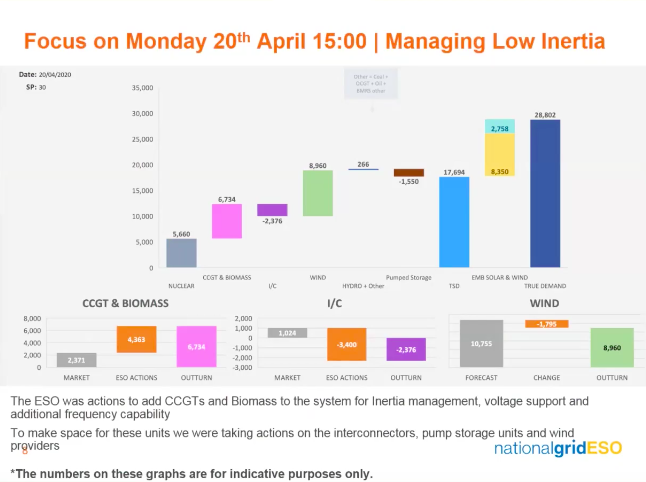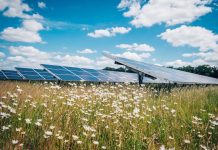National Grid ESO is working out how to manage low demand on the transmission system exacerbated by the coronavirus lockdown. One option is paying solar generators to stop exporting.
The ESO has been holding weekly briefings around Covid-19 preparedness. Last week, it outlined the impact of embedded solar on reduced transmission demand – and the measures it has to take to keep the system stable.
On the afternoon of Monday 20 April, these included turning off 1.8GW of wind, asking pumped storage operators to use electricity by pumping water uphill, and exporting gigawatts via interconnectors. Yet Grid still had to bring on more than 4GW of biomass and gas-fired power stations to ensure it had the right tools to keep the system stable.

The table above shows the tradeoffs the system operator has to make. Over summer, the challenge will only increase.
The ESO said it has planned for demand to regularly drop to 15GW from mid-May until the end of lockdown. On warm, windy nights, it could fall as low as 13GW.
Solar eclipse?
To help manage system stability in a low demand, high renewables system, Grid is now looking at recommencing its demand turn up (DTU service) and developing a commercial service to access distributed energy resource, i.e. embedded solar.
Rob Rome, commercial operations manager at the ESO, said there was “a lot of co-ordination” now taking place with distribution networks and others “to get a commercial service started and how best to attack that.”
What that service looks like will become clearer in the next few weeks. But the market is interested.
“They are turning off wind farms, so it is no worse than that,” said Flexitricity chief strategy officer, Alastair Martin. Turning off embedded solar “is more interesting from our point of view.”
While it is unclear if any DER constraint service will progress to a formal market, the ESO “is clearly opening that door,” he added.
Battery booster
Martin thinks a solar constraint product could also spur investment in co-location of battery storage at solar sites.
“It’s clearly better to store power than throw it away. So that feeds into the business case for batteries. The more signals around the true value of flexibility, the more [storage] will be built.”
Footroom fix
In the meantime, if National Grid does decide to resurrect demand turn up, it will need to fix one fundamental flaw, Martin suggests.
DTU, he says, suffered because providers were exposed to imbalance prices. Whereas in other services that problem was solved by the Applicable Balancing Services Volume Data (ABSVD) readjustment methodology, DTU was not deemed an ‘Applicable Balancing Service’.
“That was DTU’s main flaw, because it opened up exposure to the imbalance price. Demand-side response customers are cautious. Providing balancing services is not their day job, and yet there was a continual risk in DTU that people would have to pay out more than they received.”
As such, DTU “never really had a chance of starting off in the right way,” Martin suggests.
However, if Grid can relaunch DTU with the ABSVD fix, “it will make a dramatic difference, because the entire imbalance risk is removed,” says Martin.
“It becomes a much more valuable proposition to customers.”
Update 28/04/20: National Grid ESO has now launched a new footroom service which will be treated as an ‘Applicable Balancing Service’. As a result, Flexitricity’s Alastair Martin said it would be a “game changer”.
Update 30/04/20: National Grid ESO has now submitted an urgent code modification to allow it to instruct DNOs to disconnect embedded generation if all other actions have been exhausted. It says the current code is too ambiguous and “would potentially leave DNOs in a position that they would feel exposed them to legal risk”.
Related stories:
National Grid launches new footroom service to tackle lockdown lows
National Grid: UK coal-free for 18 days
Coronavirus demand destruction gives National Grid another plate to spin
National Grid mulls footroom options as demand drops
Coronavirus and the power system: Keep calm and put the kettle on
Fintan Slye: Inertia has been taken for granted, it will become much more important
Demand turn up ‘not an enduring’ service, Grid to review
Demand turn up: What worked, what didn’t?
As solar generation makes history, National Grid starts to feel the burn
Click here to see if you qualify for a free subscription to the print magazine, or to renew.
Follow us at @EnergystMedia. For regular bulletins, sign up for the free newsletter.



